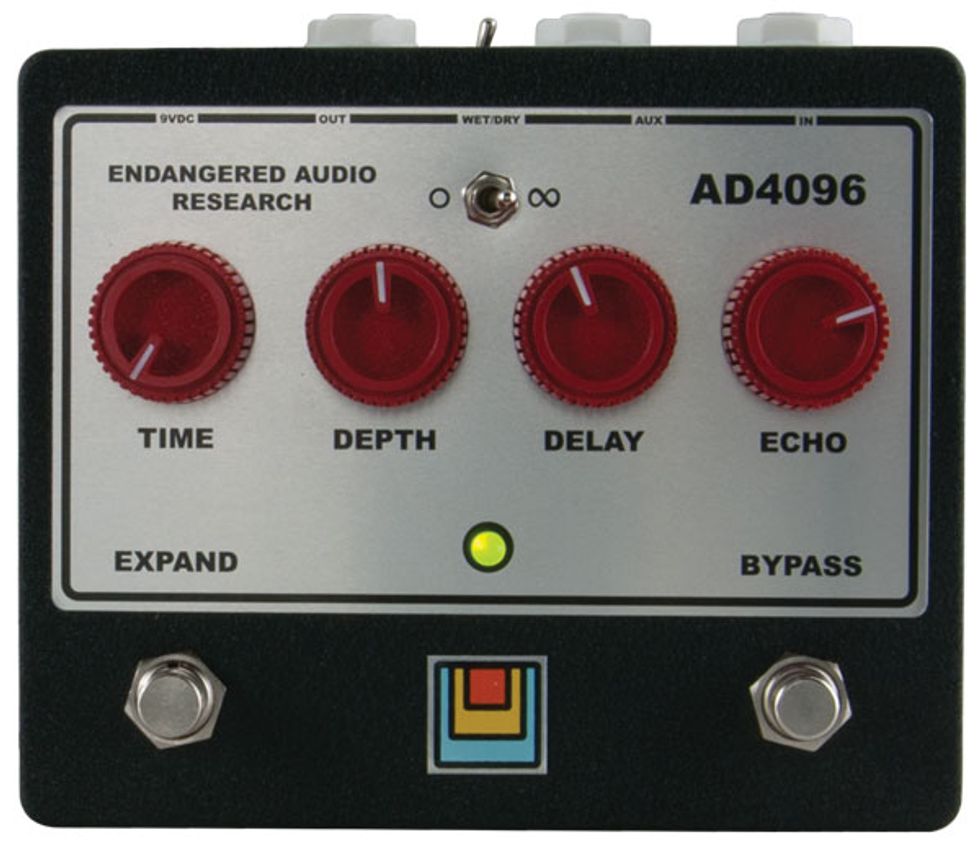Last year I spotted an Endangered Audio AD4096 at Asheville, North Carolina’s wonderful Sherwood’s Music. I had no idea how it sounded and didn’t exactly have $375 burning a hole in my pocket, but having a soft spot for aesthetics, I pulled it from the display case and plugged it into a Traynor. Less than 10 minutes later I was at the counter with my credit card. So by the time Premier Guitar assigned this review, I had a jump on things.
Unconventionally Simple
Like pedals by Moog and Blackout Effectors, the AD4096 is made in Asheville. (What is it in the water there?) It’s designed by the folks who built the Gristleizer, a device inspired by the work of industrial experimentalists Throbbing Gristle. These are audio heads with a taste for the unconventional.
There’s much vintage Maestro in AD4096’s design. The cool red knobs on the front panel are the main controls. Time adjusts the repeat rate between 40 and 400ms. Oddly, turning the knob from left to right decreases delay time, which may take some getting used to. Depth takes the number of repeats from one to self-oscillation. Delay is a mix knob. (It would have made more sense to call it just that.) Echo is a wonderful feature that adds a doubling wash to the main delayed signal. There are also bypass and expand footswitches. The latter is a momentary switch that throws the delay into self-oscillation when held. Apart from the Sib! Mr. Echo and Boss’ RE20, few delays include this useful feature.
Ratings
Pros:
A simple, great-sounding delay with unique and musical features.
Cons:
Labeling could be clearer.
Tones:
Playability/Ease of Use:
Build/Design:
Value:
Street:
$379
Endangered Audio Research AD4096 Analog Delay
endangeredaudioresearch.com
The small footprint means there’s no room for a battery, but since delays suck nine volts down like a sailor on leave swilling beer, it’s a minor concern. A mini-toggle above the knobs switches between normal and infinity modes—perhaps the secret sauce of this delay.
The rear panel hosts in and out jacks, plus a mini-toggle that controls the adjoining aux out jack. In dry mode no delayed signal passes through the aux send. Switched to wet, it passes delayed signal only, even when the effect is bypassed, creating possibilities for routing, spillover, and multi-amp setups. It’s a smart design, with the most frequently used features dominating the faceplate while the extras are small or tucked away.
Analog Ace At its heart this is a solid and beautiful analog delay. It’s not as dark as an Ibanez AD-9, as wild as an EHX Memory Man, or as perfectly simple as Boss’s DM series delays, but it works from the same sonic base: colorful, dark, and deep repeats. Typically for an old- school bucket brigade delay, decaying echoes lose fidelity (or take on color, depending on your perspective). There’s also a little noise, but nothing approaching what you’d hear from a vintage Memory Man.
The infinity switch works a little like sound-on-sound mode on an Echoplex, but the effect sits subtly in the background. The resulting cathedral-like echoes add a complimentary aura that never overshadows the primary repeats. This will be of particular interest to the space rock set, though you could use it for extra texture in more conventional applications.
The Verdict Endangered Audio’s AD 4096 embodies everything players love about analog delays, while adding standout features, such as the expand and infinity settings. Vintage Memory Man and AD-9 units fetch as much as the AD4096, but the Endangered Audio pedal is at least as well built and delivers equally pleasing tones. While you can find analog delays capable of some of these dark tones at half the price, the AD4096’s extra features are musical and useful, and it’s beautifully hand-built from top-shelf components.


















